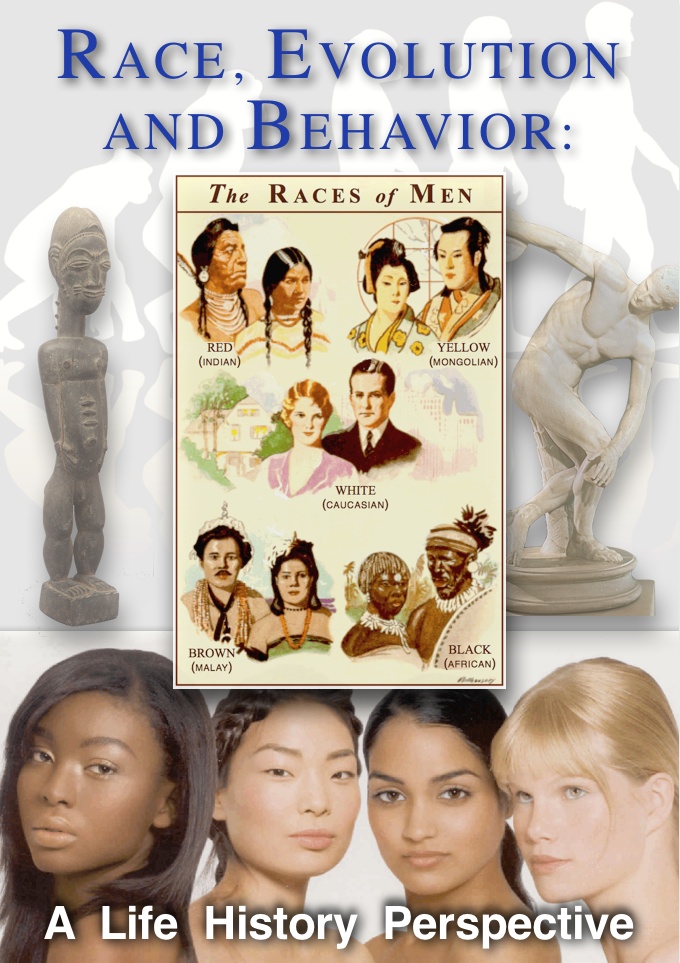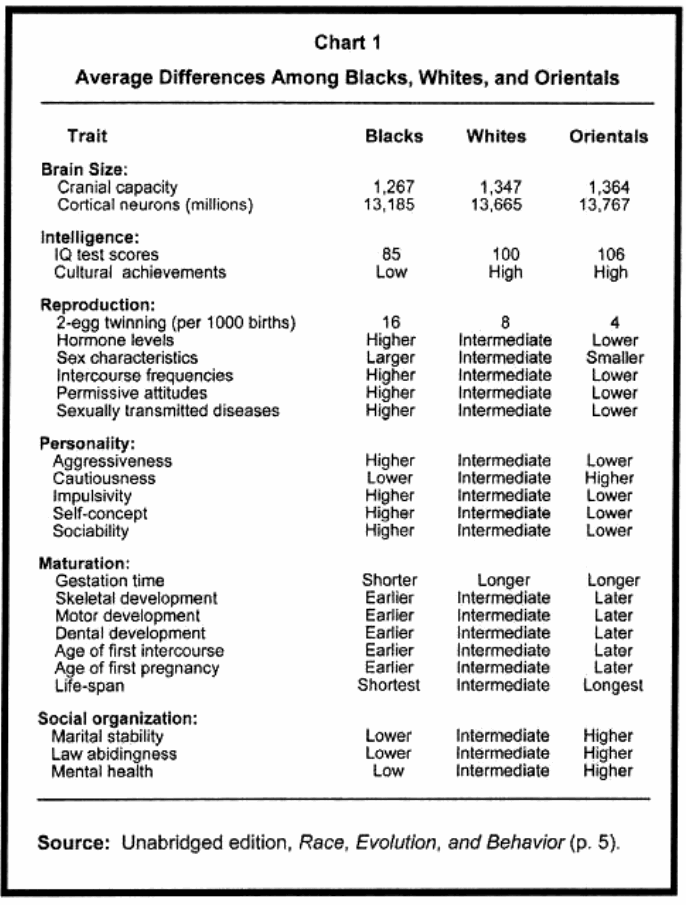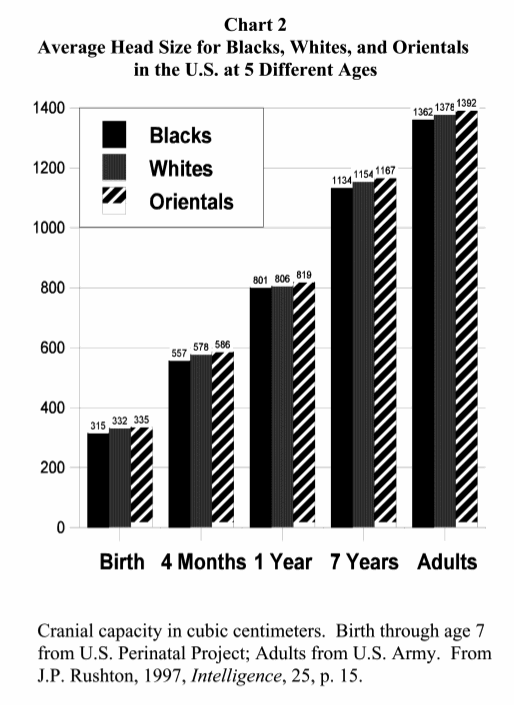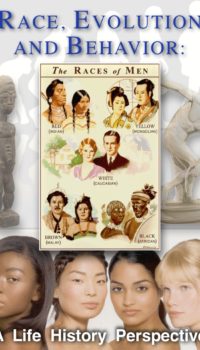RACE, EVOLUTION, AND BEHAVIOR:
A Life History Perspective
[Part 1]
2nd Special Abridged Edition
By Professor J. Philippe Rushton
University of Western Ontario
London, Ontario, Canada N6A 5C2
[Page 2]
Acclaim for J. Philippe Rushton’s Race, Evolution, and Behavior
“(An) incendiary thesis …. that separate races of human beings evolved different reproductive strategies to cope with different environments and that these strategies led to physical differences in brain size and hence in intelligence. Human beings who evolved in the warm but highly unpredictable environment of Africa adopted a strategy of high reproduction, while human beings who migrated to the hostile cold of Europe and northern Asia took to producing fewer children but nurturing them more carefully.”
— Malcolm W. Browne, New York Times Book Review
“Rushton is a serious scholar who has assembled serious data. Consider just one example: brain size. The empirical reality, verified by numerous modern studies, including several based on magnetic resonance imaging, is that a significant and substantial relationship does exist between brain size and measured intelligence after body size is taken into account and that the races do have different distributions of brain size.”
— Charles Murray, Afterword to The Bell Curve
“Describes hundreds of studies worldwide that show a consistent pattern of human racial differences in such characteristics as intelligence, brain size, genital size, strength of sex drive, reproductive potency, industriousness, sociability, and rule following. On each of these variables, the groups are aligned in the order: Orientals, Caucasians, Blacks.”
— Mark Snyderman, National Review
“Rushton’s Race, Evolution, and Behavior … is an attempt to understand[race] differences in terms of life-history evolution. … Perhaps there ultimately will be some serious contribution from the traditional smoke-and-mirrors social science treatment of IQ, but for now Rushton’s framework is essentially the only game in town.”
— Henry Harpending, Evolutionary Anthropology
“This brilliant book is the most impressive theory-based study … of the psychological and behavioral differences between the major racial groups that I have encountered in the world literature on this subject.”
— Arthur R. Jensen, University of California, Berkeley
“The only acceptable explanation of race differences in behavior allowed in public discourse is an entirely environmental one … Professor Rushton deserves our gratitude for having the courage to declare that ‘this emperor has no clothes,’ and that a more satisfactory explanation must be sought.”
— Thomas J. Bouchard, Jr., University of Minnesota
“The remarkable resistance to racial science in our times has led to comparisons with the inquisition of Rome, active during the Renaissance. … Astronomy and the physical sciences had their Copernicus, Kepler, and Galileo a few centuries ago; society and the welfare of humanity is the better for it today. In a directly analogous fashion, psychology and the social sciences today have their Darwin, Galton, and Rushton.”
— Glayde Whitney, Contemporary Psychology
“The data are startling to the uninitiated. … Race, Evolution, and Behavior confronts us as few books have with the dilemmas wrought in a democratic society by individual and group differences in key human traits.”
— Linda Gottfredson, Politics and the Life Sciences
“Professor Rushton is widely known and respected for the unusual combination of rigour and originality in his work. … Few concerned with understanding the problems associated with race can afford to disregard this storehouse of well-integrated information which gives rise to a remarkable synthesis.”
— Hans J. Eysenck, University of London
“Should, if there is any justice, receive a Nobel Prize.”
— Richard Lynn, Spectator.
[Page 3]
Race, Evolution, and Behavior: A Life History Perspective 2nd Special Abridged Edition J. Philippe Rushton Race, Evolution, and Behavior 2nd Special Abridged Edition Copyright 2000 by J. Philippe Rushton All rights reserved. Published by the Charles Darwin Research Institute Port Huron, MI 1st (1995) and 2nd (1997) Unabridged editions published by Transaction Publishers, New Brunswick, NJ. Japanese translation of 1st edition published by Hakuhin-sha of Tokyo (1996). 1st Special Abridged Edition published by Transaction Publishers (1999). Library of Congress Card Number: 00-103721 ISBN: 0-9656836-2-1 Printed in the United States of America Rushton, J. Philippe, 1943- Race, Evolution, and Behavior: A Life History Perspective/J. Philippe Rushton. — 2nd spec. ab. ed.[GN 281:4.R87 2000].
[Page 4]
Author
J. Philippe Rushton is a professor of psychology at the University of Western Ontario, London, Ontario, Canada. Rushton holds two doctorates from the University of London (Ph.D. and D.Sc) and is a Fellow of the John Simon Guggenheim Foundation, the American Association for the Advancement of Science, and the American, British, and Canadian Psychological Associations. He is also a member of the Behavior Genetics Association, the Human Behavior and Evolution Society, and the Society for Neuroscience. Rushton has published six books and nearly 200 articles. In 1992 the Institute for Scientific Information ranked him the 22nd most published psychologist and the 11th most cited. Professor Rushton is listed in Who’s Who in Science and Technology, Who’s Who in International Authors, and Who’s Who in Canada.
[Page 5]
Contents
Preface 6
1. Race is More Than Skin Deep 7
Race in History
Race in Today’s World
Why Are There Race Differences?
Conclusion
Additional Readings
2. Maturation, Crime, and Parenting 13
Maturation
Crime
Personality, Aggression, and Self-Esteem
Parenting and Out-of-Wedlock Births
Longevity and Population Growth
Conclusion
Additional Readings
3. Sex, Hormones, and AIDS 18
Sexual Behavior and Attitudes
Sexual Physiology and Anatomy
AIDS and HIV
Conclusion
Additional Readings
4. Intelligence and Brain Size 22
Culture Fair Tests
Intelligence and Brain Size
Race Differences in Brain Size
Magnetic Resonance Imaging
Brain Weight at Autopsy
Measuring Skull Size
Measuring Living Heads
Summarizing Brain Size Differences
Conclusion
Additional Readings
5. Genes, Environment, or Both? 28
Heritability Studies
Adoption Studies
Race and Heritability
Trans-racial Adoption Studies
Heritabilities Predict Racial Differences
Regression to the Average
Conclusion
Additional Readings
6. Life History Theory 34
r-K Life History Theory
Race Differences and r-K Strategies
Testosterone — The Master Switch?
Conclusion
Additional Readings
7. Out of Africa 39
The Evidence
Geography and Race
Conclusion
Additional Readings
8. Questions and Answers 42
Is Race a Useful Concept? (Chapter 1)
Are the Race Differences Real? (Chapters 2 through 5)
Is the Relationship Between Race and Crime Valid? (Chapter 2)
Is the Relationship Between Race and Reproduction Valid? (Chapter 3)
Is the Genetic Evidence Flawed? (Chapter 5)
Is r-K Theory Correct? (Chapter 6)
Aren’t Environmental Explanations Sufficient? (Chapter 5)
Is Race Science Immoral? (Chapter 1)
Closing Thoughts
Additional Readings
[Page 6]
Preface to 2nd Special Abridged Edition
The first printing of this Special Abridged Edition appeared in 1999 by Transaction Publishers. It followed up on their successful 1995 and 1997 publications of the 1st and 2nd unabridged editions and a Japanese translation published by Hakuhin-sha in 1996.
However, when Transaction distributed thousands of copies of the Special Abridged Edition in a mass mailing to academics, a firestorm of controversy engulfed them. Although the Abridged Edition presented the same research in a condensed and popularly written style, similar to that used for articles in Discover Magazine, Reader’s Digest, and Scientific American, the Progressive Sociologists, and some other self-styled “anti-racists,” threatened Transaction with loss of a booth at annual meetings, advertising space in journals, and access to mailing lists if they continued to send it out.
Transaction caved in to this pressure, withdrew from publishing the book, and even apologized. Transaction’s letter of apology appeared on the inside front cover of their flagship journal Society (January/February, 2000). Accounts of the affair appeared in The Chronicle of Higher Education (January 14, 2000), Canada’s National Post (January 31, 2000), the National Report (February 28, 2000), and elsewhere.
Why the attempt to trash or suppress this booklet? Because there is no stronger taboo today than talking about race. In many cases, just being accused of “racism” can get you fired. Yet, teachers in America know the races differ in school achievement; policemen know the races differ in crime rates; social workers know the races differ in rates of welfare dependency or getting infected with AIDS. And sports fans know that Blacks excel at boxing, basketball, and running. They all wonder why. Some blame poverty, White racism, and the legacy of slavery. Although many doubt that “White racism” really tells the whole story, few dare share their doubts. When it comes to race, do you really dare to say what you think?
Racial groups differ much more widely than many people realize. Yet vocal groups in academia and the media simply forbid letting the public in on an open discussion. Many worry that just mentioning that the races differ creates stereotypes and limits opportunities. But looking at race does not mean ignoring individuals. It may even help us become more aware of each person’s special needs.
This book presents the scientific evidence that race is a biological reality that has both scientific and everyday meaning. Other recent books on the issue are: The Bell Curve (the 1994 best seller by Richard Herrnstein and Charles Murray), Why Race Matters (a 1997 book by philosopher Michael Levin), The g Factor (a 1998 book by psychologist Arthur Jensen), and TABOO: Why Black Athletes Dominate Sports and Why We Are Afraid to Talk About It (a recent book by award winning journalist Jon Entine).
For more detailed information on any of the topics in this Special Abridged Edition, please read the corresponding sections in one of the unabridged editions, which contain over 1,000 references to the scholarly literature, a glossary, complete name and subject indexes, and 65 tables and figures. You can also point and click to the www.charlesdarwinresearch.org which published this booklet for more information. May, 2000 J. Philippe Rushton Department of Psychology University of Western Ontario, London, Ontario, Canada N6A 5C2.
[Page 7]
1: Race Is More Than Skin Deep
Is race real? Do the races differ in behavior as well as in body? Are such views just the result of white racism? Modern science shows a three-way pattern of race differences in both physical traits and behavior. On average, Orientals are slower to mature, less fertile, less sexually active, less aggressive, and have larger brains and higher IQ scores. Blacks are at the other pole. Whites fall in the middle, but closer to Orientals than to Blacks.
White men can’t jump. Asian men can’t either. But according to Jon Entine’s new book, Taboo: Why Black Athletes Dominate Sports and Why We Are Afraid to Talk About It, Black men — and women — sure can. The usual reason given for Black athletic success is that Blacks have little chance to get ahead elsewhere. But Entine’s new book shows that in sports, Blacks have a genetic edge.
The physical facts Entine reviews are quite well known. Compared to Whites, Blacks have narrower hips which gives them a more efficient stride. They have a shorter sitting height which provides a higher center of gravity and a better balance. They have wider shoulders, less body fat, and more muscle. Their muscles include more fast twitch muscles which produce power. Blacks have from 3 to 19% more of the sex hormone testosterone than Whites or East Asians. The testosterone translates into more explosive energy.
Entine points out that these physical advantages give Blacks the edge in sports like boxing, basketball, football, and sprinting. However, some of these race differences pose a problem for Black swimmers. Heavier skeletons and smaller chest cavities limit their performance.
Race differences show up early in life. Black babies are born a week earlier than White babies, yet they are more mature as measured by bone development. By age five or six, Black children excel in the dash, the long jump, and the high jump, all of which require a short burst of power. By the teenage years, Blacks have faster reflexes, as in the famous knee-jerk response.
East Asians run even less well than Whites. The same narrow hips, longer legs, more muscle, and more testosterone that give Blacks an advantage over Whites, give Whites an advantage over East Asians. But admitting these genetic race differences in sports leads to the greater taboo area — race differences in brain size and crime. That is why it is taboo to even say that Blacks are better at many sports.
The reason why Whites and East Asians have wider hips than Blacks, and so make poorer runners is because they give birth to larger brained babies. During evolution, increasing cranial size meant women had to have a wider pelvis. Further, the hormones that give Blacks an edge at sports makes them restless in school and prone to crime.
Race in History
Even before there were any intelligence tests, philosophers, statesmen, merchants, and others thought there was a link between race, intelligence, and cultural achievement. Aristotle, Plato, Voltaire, and David Hume all believed this. So did Broca, Darwin, Galton, and all the founders of evolution and anthropology. Even Freud believed in some race differences. But this began to change in the 1920s with Franz Boas and James B. Watson, who believed that culture could change just about anything. Today, writers like Jared Diamond in Guns, Germs and Steel (1997) and S. J. Gould in The Mismeasure of Man (1996) tell us there is no link between race, intelligence, and culture. The differences we see are all just because of bad luck or White racism.
[Page 8]
The first explorers in East Africa wrote that they were shocked by the nudity, paganism, cannibalism, and poverty of the natives. Some claimed Blacks had the nature;
“of wild animals … most of them go naked … the child does not know his father, and they eat people.”
Another claimed they had a natural sense of rhythm so that if a Black;
“were to fall from heaven to earth he would beat time as he goes down.”
A few even wrote books and made paintings of Africans with over-sized sex organs.
Sound familiar? All just a reflection of racism? Maybe so, but these examples are not from 19th Century European colonialists or KKK hate literature. They come from the Muslim Arabs who first entered Black Africa over 1,200 years ago (in the 700s), as detailed in Bernard Lewis’s 1990 book, Race and Slavery in the Middle East.
Several hundred years later, European explorers had the same impressions. They wrote that Africans seemed to have a very low intelligence and few words to express complex thoughts. They praised some tribes for making fine pottery, forging iron, carving wooden art, and making musical instruments. But more often, they were shocked by the near nakedness of the people, their poor sanitary habits, simple houses, and small villages. They found no wheels for making pots, grinding corn, or for transport, no farm animals, no writing, no money, and no numbering systems.
The Whites who explored China were just as racist as those who explored Africa, but their descriptions were different from what they and the Arabs had written about Africans. In 1275 Marco Polo arrived in China from his native Italy to open trade with the Mongol Empire. He found that the Chinese had well built roads, bridges, cities connected by canals, census takers, markets, standardized weights and measures, and not only coins, but paper money as well. Even a postal system was in existence. All of these made him marvel when he compared the Chinese to what he saw in Europe and the Middle East. Even though he was an Italian, proud of his people and well aware of the greatness of Ancient Rome, Marco Polo wrote: “Surely there is no more intelligent race on earth than the Chinese.”
Historical research bears out Marco Polo’s impressions. As early as 360 B.C., the Chinese used the cross bow and changed the face of warfare. Around 200-100 B.C., the Chinese used written exams to choose people for the civil service, two thousand years before Britain. The Chinese used printing about 800 A.D., some 600 years before Europe saw Gutenberg’s first Bible. Paper money was used in China in 1300, but not in Europe until the 19th and 20th centuries. By 1050 Chinese chemists had made gunpowder, hand grenades, fire arrows, and rockets of oil and poison gas. By 1100, factories in China with 40,000 workers were making rockets. Flame throwers, guns, and cannons were used in China by the 13th century, about 100 years before Europe.
The Chinese used the magnetic compass as early as the 1st century. It is not found in European records until 1190. In 1422, seventy years before Columbus’s three small ships crossed the Atlantic, the Chinese reached the east coast of Africa. They came in a great fleet of 65 ocean going ships filled with 27,000 soldiers and their horses, and a year’s supply of grain, meat, and wine. With their gunpowder weapons, navigation, accurate maps and magnetic compasses, the Chinese could easily have gone around the tip of Africa and “discovered” Europe!
In the last five centuries, the European nations leapfrogged over the Chinese in science and technology. Since 1950, however, Japan has beaten the West in the production of many high-tech products. Other Pacific Rim countries (China, Taiwan, Singapore, and South Korea) now follow Japan’s path. Africa, on the other hand, has fallen further behind. The poor conditions of African countries and Black America have become a concern to many. Much of the optimism of the U.S. Civil Rights movement of the 1960s is gone, along with the high hopes for independent African nations. Trillions of dollars of foreign aid have poured into Africa. Yet African economies have declined since the Europeans left.
Neglect and decay are seen everywhere in Africa and much of the West Indies. International corporations often have to provide their own power, their own water, and their own phones. In the age of computers, fax machines, and the world wide web, getting a dial tone in many African cities is difficult.
[Page 9]
Race in Today’s World
For the past twenty years I have studied race differences in brain size, intelligence, sexuality, personality, growth rate, life span, crime, and family stability. On all of these traits, Orientals fall at one end of the spectrum, Blacks fall at the other end, and Whites fall in between.
Chart 1 lists the differences between the three major races: Orientals (East Asians, Mongoloids), Whites (Europeans, Caucasoids), and Blacks (Africans, Negroids). To keep things simple, I will use these common names instead of scientific ones and will not discuss subgroups within the races.
On average, Orientals are slower to mature, less fertile, and less sexually active, have larger brains and higher IQ scores. Blacks are at the opposite end in each of these areas. Whites fall in the middle, often close to Orientals. The evidence shows that this is due to both genes and environment. I have suggested an evolutionary theory to explain this three-way pattern.
Of course, these differences are averages. The full range of behaviors, good and bad, is found in every race. No group has a monopoly on virtue or vice, wisdom or folly. However, this pattern is true over time and across nations and this means that we cannot ignore it.
[Page 10]
Plan of the Book
This chapter briefly describes the 3-way pattern of race differences. The following chapters provide more detail.
Many statistics in Chart 1 come from the United States, where Orientals are a “model minority.” They have fewer divorces, fewer out-of-wedlock births, and fewer reports of child abuse than Whites. More Orientals graduate from college and fewer go to prison.
On the other hand Blacks are 12% of the American population and make up 50% of the prison population. In the U.S., one out of every three Black men is either in jail, on probation, or awaiting trial. That is much more than the number who graduate from college.
Chapter 2 shows how this racial pattern in crime is found worldwide. INTERPOL Yearbooks show the rate of violent crime (murder, rape, and serious assault) is four times lower in Asian and Pacific Rim countries than in African and Caribbean countries. Whites in the United States and in European countries are intermediate. The 1996 INTERPOL violent crime rates clearly show this pattern: Asian countries, 35 violent crimes per 100,000 people; European countries, 42; and African countries, 149.
Chapter 2 also finds that Oriental children are slower to mature than White children while Black children are faster to mature. This is true for the rate of bone and tooth development and the age at which a child first sits, crawls, walks, and puts on clothing. Oriental children do not begin to walk until about 13 months, White children at 12 months, and Black children at 11 months.
Chapter 3 looks at racial differences in sexual activity. Orientals are the least sexually active, whether measured by age of first intercourse, intercourse frequency, or number of sexual partners. Blacks are the most active on all of these. Once again Whites are in between. These contrasts in sexual activity lead to differences in the rate of diseases like syphilis, gonorrhea, herpes, and chlamydia. There are high levels of AIDS in Africa, Black America, and the Caribbean and low levels in China and Japan. European countries again fall in between.
The races differ in rate of ovulation (Chapter 3). Not all women produce one egg during the menstrual cycle. When two or more eggs are produced at the same time, a pregnancy is more likely. So is the likelihood of producing fraternal twins (i.e., two-egg twins). The number of twins born is 16 out of every 1,000 births for Blacks, 8 out of every 1,000 births for Whites, and 4 or less for Orientals. Triplets and other multiple births are rarest in Orientals and highest in Blacks, with Whites in between.
Chapter 4 is about race and intelligence. Hundreds of studies on millions of people show a three- way pattern. IQ tests are often made to have an average score of 100, with a “normal” range from 85 to 115. Whites average from 100 to 103. Orientals in Asia and the U.S. tend to have higher scores, about 106, even though IQ tests were made for use in the Euro-American culture. Blacks in the U.S., the Caribbean, Britain, Canada, and in Africa average lower IQs — about 85. The lowest average IQs are found for sub-Saharan Africans — from 70 to 75.
Chapter 4 also looks at brain size. Bigger brains have more brain cells and this leads to higher IQs. The races vary in brain size. The Collaborative Perinatal Project followed more than 35,000 children from birth to seven years. Orientals had larger brains than Whites at birth, four months, one year, and seven years. Whites had larger brains than Blacks at all ages (see Chart 2). The data on adults in Chart 2 come from a sample of 6,325 U.S. Army personnel.
Chapter 5 asks whether differences in our brain size, our bodies and our behavior are because of genes, environment, or both. It also asks whether individual differences can tell us anything about race differences.
[Page 11]
Why Are There Race Differences?
Why does history show Africa trailing behind Asia and Europe? Why do Whites average between Orientals and Blacks in so many areas? Why do the groups with larger brains have lower rates of two-egg twinning? To know the answer you must look at all of the traits taken together (see Chart 1).
The traits in Chart 1 form a pattern. No known environmental factor can explain all of them taken together. There is, however, a gene based explanation. The patterns make up what is called a “life-history.” They evolved together to meet the trials of life — survival, growth, and reproduction.
[Page 12]
Chapter 6 discusses the gene based “life-history theory” I have proposed to explain the racial pattern in brain size, intelligence, and other traits. Evolutionary biologists call it the r-K scale of reproductive strategies. At one end of this scale are r-strategies that rely on high reproductive rates. At the other end are K-strategies that rely on high levels of parental care. This scale is generally used to compare the life histories of different species of animals. I have used it to explain the smaller but real differences between the human races.
On this scale, Orientals are more K-selected than Whites, while Whites are more K-selected than Blacks. Highly K-selected women produce fewer eggs (and have bigger brains) than r-selected women. Highly K-selected men invest time and energy in their children rather than the pursuit of sexual thrills. They are “dads” rather than “cads.”
Chapter 7 shows that the race differences in reproductive strategies make sense in terms of human evolution. Modern humans evolved in Africa about 200,000 years ago. Africans and non-Africans then split about 100,000 years ago. Orientals and Whites split about 40,000 years ago.
The more north the people went “Out of Africa,” the harder it was to get food, gain shelter, make clothes, and raise children. So the groups that evolved into today’s Whites and Orientals needed larger brains, more family stability, and a longer life. But building a bigger brain takes time and energy during a person’s development. So, these changes were balanced by slower rates of growth, lower levels of sex hormones, less aggression, and less sexual activity.
Why? Because Africa, Europe, and Asia had very different climates and geographies that called for different skills, resource usage, and lifestyles. Blacks evolved in a tropical climate which contrasted with the cooler one of Europe in which Whites evolved and even more so with the cold Arctic lands where Orientals evolved.
Because intelligence increased the chances of survival in harsh winter environments, the groups that left Africa had to evolve greater intelligence and family stability. This called for larger brains, slower growth rates, lower hormone levels, less sexual potency, less aggression, and less impulsivity. Advanced planning, self-control, rule-following, and longevity all increased in the non-Africans.
I realize that these topics are controversial and that readers will have many questions. Chapter 8 lists the questions I am most asked about Race, Evolution, and Behavior, and my answers to them.
Conclusion
Race is more than “just skin deep.” The pattern of Oriental-White-Black differences is found across history, geographic boundaries, and political-economic systems. It proves the biological reality of race. Theories based only on culture cannot explain all the data shown in Chart 1. The next three chapters describe the scientific findings on race differences (summarized in Chart 1) in greater detail. Later chapters explain why these differences follow such a pattern.
Additional Readings
Entine, J. (2000). Taboo: Why Black Athletes Dominate Sports and Why We Are Afraid to Talk About It. New York: Public Affairs Press.
Lewis, B. (1990). Race and Slavery in the Middle East. New York: Oxford University Press.
Rushton, J. P. (1997). Cranial size and IQ in Asian Americans from birth to age seven. Intelligence, 25, 7-20.
Click here for Race, Evolution and Behavior >>>
Part 1: Preface; Race is More Than Skin Deep
Part 2: Maturation, Crime, and Parenting
Part 3: Sex, Hormones, and AIDS
Part 4: Intelligence and Brain Size
Part 5: Genes, Environment, or Both?
PDF of this blog post.
Race, Evolution, and Behavior – Part 1 Ver 2
Version History
Version 4: Jan 13, 2020 — Re-uploaded images and PDF for katana17.com/wp/ version.
Version 3: Aug 12, 2015 — Added Cover page; improved formatting; added updated Ver 2 PDF.
Version 2: Added PDF for download – Jun 11, 2014
Version 1: Published Jun 10, 2014






Professor Rushton attributes the higher average intelligence of Europeans and Orientals to living in a cold climate. That is part of it. Nevertheless, Neanderthals lived in Europe for several hundred thousand years during several ice ages. The shapes of their brains and remains of their camp sites indicate that they were less intelligent than the Cro Magnons who displaced them, and who were descended from people who had much more recently immigrated from Africa.
In The 10,000 Year Explosion:How Civilization Accelerated Human Evolution Professors Gregory Cochran and Henry Harpending attribute the higher average intelligence of Europeans and Orientals to ten thousand years of agriculture, and five thousand years of civilization.
Nevertheless, agriculture and civilization began in the Mid East about a thousand years earlier than they began in the Far East. Moreover, civilization began in Egypt, and in what is now Iraq. Egyptians and Iraqis have average IQ’s significantly lower than Europeans and Orientals. Finally, Orientals have higher IQ averages than Europeans.
Nevertheless, it is clear to me that climate, agriculture, and civilization have contributed to the evolution of higher intelligence in certain races. One does not need to explain everything to explain anything.
Pingback: How Africans May Differ from Westerners - katana17katana17
Pingback: RACE, EVOLUTION, AND BEHAVIOR - Part 2: Maturation, Crime, and Parenting - katana17katana17
Pingback: RACE, EVOLUTION, AND BEHAVIOR - Part 3: Sex, Hormones, and AIDS - katana17katana17
Pingback: RACE, EVOLUTION, AND BEHAVIOR - Part 4: Intelligence and Brain Size - katana17katana17
Pingback: RACE, EVOLUTION, AND BEHAVIOR - Part 5: Genes, Environment, or Both? - katana17katana17
Pingback: RACE, EVOLUTION, AND BEHAVIOR - Part 6: Life History Theory - katana17katana17
Pingback: RACE, EVOLUTION, AND BEHAVIOR - Part 7: Out of Africa - katana17katana17
Pingback: RACE, EVOLUTION, AND BEHAVIOR - Part 8: Questions and Answers - katana17katana17
Pingback: Australian Senator Fraser Anning Rightly Calls for a "Final Solution" — TRANSCRIPT - katana17katana17
Pingback: Charles Veitch – French Riots & Worst Film I’ve Ever Seen – Jun 30, 2023 – Transcript | katana17
Pingback: Australian Prime Minister Sir Robert Menzies on the ‘White Australia Policy’ – 1955 – Transcript | katana17
Pingback: Mark Collett – Andrew Tate – An Anti-White Creep Who Exploits Men – Jul 21, 2023 – Transcript | katana17
Pingback: Mark Collett – South Africa Today, Tomorrow the West – Aug 11, 2023 – Transcript | katana17
Pingback: Keith Woods – Chris Langan – The Great Replacement – Mar 29, 2022 – Transcript | katana17